Banking on the survival of San Francisco’s Central SoMa Plan, Tishman Speyer is pushing forward with plans to completely redevelop the northeast corner of Brannan and Fifth Streets, across from the San Francisco Tennis Club site.
Having been completely redesigned by Michael Maltzan Architecture last year, the refined plans for the 4.5-acre site, which includes three mid-block parcels stretching from 639-651 Bryant Street, would yield three new commercial buildings rising up to 185 feet in height, with a new 40,000-square-foot public park in the middle of the development and an adjacent 12,800-square-foot parcel (“Building 4”) which is to be dedicated to the Mayor’s Office of Housing and Community Development for the construction of a future affordable housing project.
Slated to be phased, the first two buildings to rise on the 598 Brannan Street parcel would be separated by a retail-lined pedestrian alley/”POPOS,” leading back to the decked out central park, which would be city-owned but funded by Tishman in the second phase of the development along with the 150-foot-tall building to rise along Bryant Street.
The three new buildings would produce a combined 923,000 square feet of new office space, 60,000 square feet of ground-floor retail and/or Production Distribution and Repair (PDR) space, a 5,500-square-foot child care center, basement garages for 200 cars and 587 bikes and some rather spectacular terrace spaces for the office tenants.
San Francisco’s Planning Commission could approve the development as proposed with the Planning Department’s blessing next week. And as we first reported earlier this month, San Francisco’s Planning Department is also recommending that the required office space allocation for the first phase of the 598 Brannan Street development be prioritized. We’ll keep you posted and plugged-in.
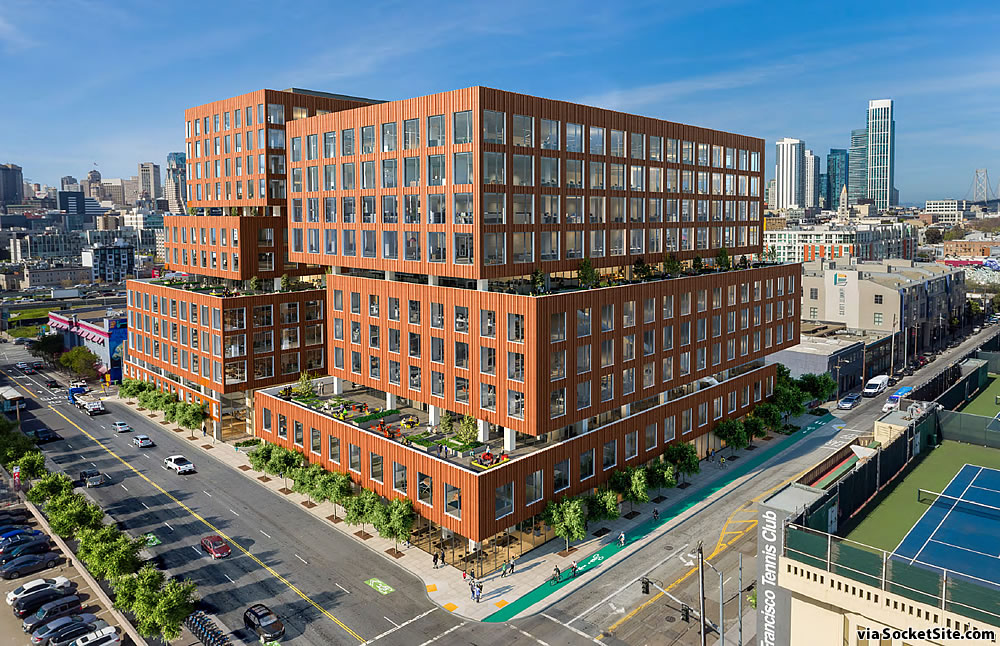
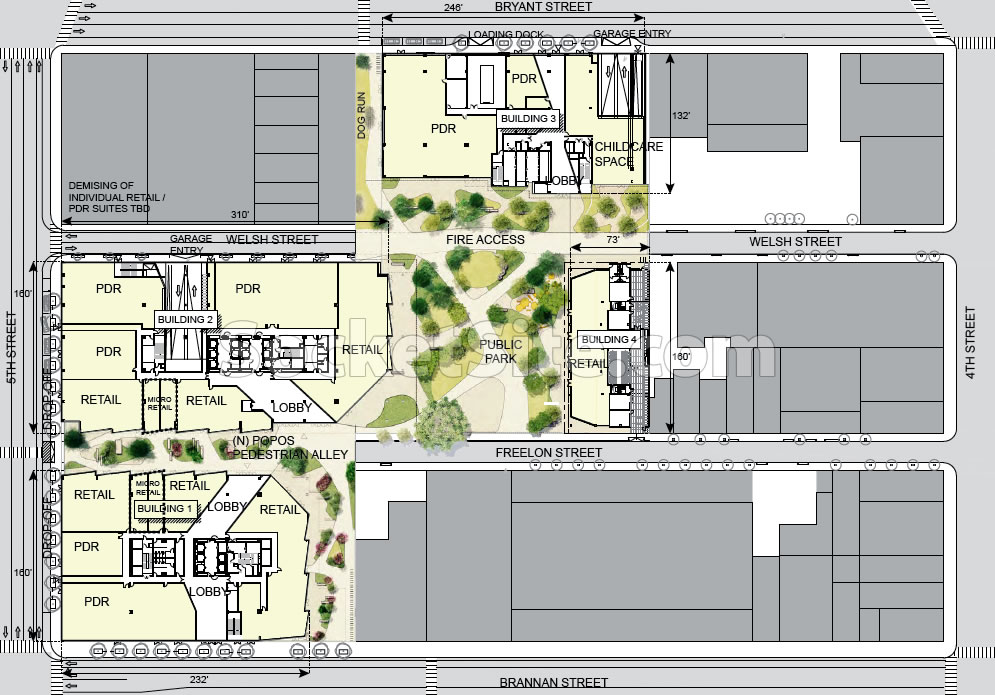
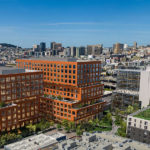
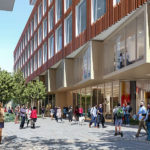
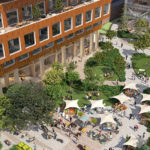
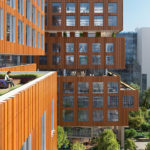
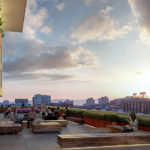
Hopefully the lawsuits against the Central SOMA plan prevail. And this misguided attempt by developers to build more offices in SF will be replaced by a new plan with maximum residential focus and minimal office focus. It will be years before the lawsuits are settled so don’t hold your breath on this one. As to the small building to the lower right in one of the images with the full roof garden – is that part of the project or just an embellishment of the image to show more green space?
That’s a placeholder for Building 4, the affordable housing component we referenced (and included in the site plan) above, which will be subject to a “Living Roof” requirement (along with the other buildings on the site).
Though they have “living” terraces, the other 3 buildings don’t seem to have “living roofs”. Per the renderings.
The real embellishment is not showing the emcampments and traffic jams.
Central Soma is going through whether you like it or not. It strikes a very good balance in a high traffic area, exactly where we should build office buildings.
Lots of people are looking forward to the development
What we need is to build the housing we can build under the approved plan now, not kick the can down the road another ten years. There are plenty of low density places left in San Francisco to build more high density housing, it doesn’t all have to be in central soma.
i think filling central SOMA with office building sounds great if we can fill western soma with 8-12 story residential buildings. We should have a goal to get 5000 more units in Western SOMA. there are so many throwaway buildings and the area needs more foot traffic besides the walking dead.
Your desire to see this plan, as well as many other nearby and similar plans, halted will be crushed. And the impotence of your obstructionist views and preferences will continue.
As someone who calls SF home, I am 100% for this. It’s great.
Beautiful project, hope it gets approved and built as quickly as possible.
Quick question – what are the modern PDR uses that could potentially fill these slots in this (and other similarly proposed) building(s)? Obviously little to none of the traditional SOMA PDR uses would be appropriate (auto repairs and such) which I’m totally fine with. But this has always seemed weird because I could not figure out what an appropriate use of this space would be. I’m assuming either way it’s because of Planning.
With a wink and a nod it seems much of new PDR space becomes tech space. Easy way to get around M given that the City generally does not seem to enforce the PDR use.
Pretty sure small-scale engineering labs and manufacturing (new tech products, usually) also count. See 100 Hooper.
Breweries are popular at the moment.
What happened to the plans to develop the Tennis Club lot?
I think the tennis set prevailed. in other words, while this project is in full swing, they’ll still be swinging at the balls next door…
That’s incorrect. As linked above: Plans to Underground the San Francisco Tennis Club Revealed (with Planning recommending a prioritized office space allocation for its development as well).
Hate to sound sick, but it’s all glorious rooftop terraces and stunning modernism street-sides, and then the less fortunate would be dwelling on #4: a diminutive structure out back, off the alleys, probably rats nearby.
Exactly! I thought #4 was an old existing bland building. However, it would be new and part of the project yet does not complement the project structures at all in terms of architecture. It takes away from the whole effect. How much more would it have cost to do a nice façade and build #4 up several stories while opening up more open space – as per the existing plans it looks completely out of place.
As noted in the editor’s reply to your comment above, Building 4 in the illustration is merely a “placeholder” subject to further massing and architectural refinement.
Let me guess…it’ll have an industrial size private cafeteria, 200 parking spots, gym for company employees etc. Just another massive gated community squat and center in the middle of SoMa. Does nothing for the neighborhood.
Central SoMa is just a giveaway to companies. They even zoned it specifically for companies who want ‘warehouse’ style open offices, rather than making housing a priority.
Well considering our increasingly anti-business climate has chased away TWO Fortune 500 headquarters away in just the past year, maybe it’s a good thing.
Please explain how our antibusiness climate has affected Salesforce, Stripe, Airbnb, Uber, Twitter, and Lyft.
As long as the market lets these companies lose billions anything SF city does is insignificant. Companies that actually have to pull a profit from a competitive industry feel the pain of costs and bureaucracy of doing business in the city.
So you’re saying that these companies are not in competitive industries.
There are definitely costs and bureaucracy in SF, but if it’s so bad, why are so many companies here? And why are Google and Facebook adding thousands of jobs in SF?
Salesforce alone dispels that take. It is a veritable titan and among the biggest 500 or so companies in the history of capitalism.. And it has now been mightily profitable for over a year. Twitter is profitable. Facebook, which hasn’t even taken up its huge SF offices yet, is profitable. Airbnb is profitable. And Uber … what? is it going away sometime, or something?
I don’t know where people get these nonsense baloney takes from. It’s not in keeping with reality.
Take a look around. Go get a coffee in Noe Valley sometime. Count the number of vehicle that pass by 24th and Noe that are not worth 50K or more in any given half hour. Go walk around Precita Park sometime on any given weekend and engage folks in conversations as to where they’re employed. Go have a beer at the Philosopher’s Club in West Portal and engage in a discussion about the changing nature of San Francisco these days.
Good grief. The people on here are so full of nonsense sometimes. Are they incapable of even looking around? or speaking to other human beings? I wonder.
The companies that can afford to stay are those that can afford sky-high rents for office space in SF. The workers they can “afford” to place here are their top tier talent. Back office workforces have mostly left SF. Middle level tech force is now being moved out of the Bay Area. SF has among the highest paid workforce in the country. It, the Bay Area really, is becoming more and more an place exclusive to the very well off and the poor. Not a good thing for a metro to become. Last year the West Coast office of the Forest Service (IIRC – a federal agency dealing with national parks and such anyway) left their high rent Bush Street offices for Vancouver. These were good paying government jobs but not tech jobs. The workers were struggling in the BA (housing and such) and the rent was prohibitive on Bush. So a hollowing out of middle tier/lower upper tier jobs is happening in SF and the BA.
And Uber … what? is it going away sometime, or something?
I certainly hope so. Uber’s…ongoing operations lost $3.5 billion in 2017, and lost $3.5 billion again in 2018. The company’s losses over the last four years from still ongoing operations were roughly $14 billion.
With that kind of money, PE investors could have funded a company that would have massively improved overall economic welfare instead of one that owes its existence to the idea that working class people with a car should declare themselves contractors in order to be better exploited.
Brahma. Uber very well might go away. But it’s early days still, really.
With respect to the any “industrial size private cafeteria”: in July of last year, The NY Times wrote San Francisco Officials to Tech Workers: Buy Your Lunch:
Emphasis mine. Wonder what happened with that proposal.
It looks like Planning Commission shot it down twice, most recently as in March ’19. But that doesn’t appear to make it completely dead.
It was always (and maybe continues to be) a stupid and misguided policy. Have these supes ever been downtown during lunch hour? Lines out the door almost everywhere. Corporate cafeterias have not visibly dented foot traffic to downtown restaurants.
After reading the comments above with nerry a mention of the San Francisco Flower market, I must concluded the Flower market will never return to the SoMa once construction begins should this development be approved by the PC.
So much for the negotiations and promises by Peskin.
There was an article in the Chronicle a few weeks ago that basically confirmed that it was unlikely the Flower Market would return. The building they were supposed to return to provides no place for all of the truck loading that is required on a daily basis, and lacked some other critical infrastructure (I forget the details) that they need. In other words, the developer never really wanted them back there and designed the project to preclude it from happening. The flower merchants are now looking for space in the Bayview.
Sorry…my bad. The flower mart [development] is at 6th and Brannan.
…one year has passed and covid took away all those who wanted this project to be completed asap. Probably now it will be delayed a couple more year, if not halted. Thanks Pinterest!!
The recently cancelled Pinterest pre-lease was for the development across the street.
UPDATE: Neighborhood Changing Development(s) Poised to Break Ground